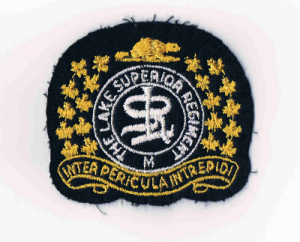Lake Superior Regiment

The Lake Superior Regiment Insignia
Though other local units, such as the 4th Field Ambulance, were mobilized immediately when war was declared in 1939, the Lake Superior Regiment had to wait until June 1940. Typically, the Canadian military was unprepared for war, and the LSR recruits trained initially with donated binoculars and target pistols; even the unit’s running shoes and sports gear had to be furnished by people in the city. Nevertheless, they marched with pride downArthur Street to the railway station on 10 October 1940 to embark for Camp Borden and more training.
Perpetuating their reputation for impertinence won during the First World War, the LSR became the first regiment at Camp Bordento go on strike. While lining up for grilled cheese sandwiches on Thanksgiving Day, 1940, the men saw turkey for the officers being wheeled by. The men promptly declared themselves on strike and went back to their barracks, refusing to leave their bunks. The protest only ended when the commanding officer, Lt. Col. Cook, authorized the kitchen to make turkey sandwiches for all, paying for the food out of his own pocket.
The regiment also had the distinction of being the first unit ever to mount a ceremonial guard on Parliament Hill; they had been called upon to mount a guard of honour for a visit by President Roosevelt. The President, however, did not visit and, in April 1941, the regiment paraded for the Mayor of Ottawa, the Governor General and Prime Minister MacKenzie-King.
For a time the LSR secured the defence of St. John, New Brunswick, and a special group of LSRs, called “Q Force”, even trained for an attack on the French Islands of St. Pierre and Miquelon. (General DeGaulle opposed Canadians occupying the tiny islands off the eastern shores of Canada, and ordered his Free French troops to take the islands).
In January 1942 the Regiment was converted to a motor battalion and given a fleet of Universal Carriers. Subsequent training delayed even longer their arrival in Europe, but when they did land in Britain in August of that year, the LSR (Motorized) had “more fighting vehicles and a greater assembly of hard-hitting weapons than any other Canadian infantry unit in history.” (Barry Wilson, 100 Years of Service.)
The Regiment landed in Normandy on 20 July 1944 and immediately assisted in the difficult task of pushing back and surrounding the German armies in France. For the next ten months, the LSR (M) fought through France, Belgium, Holland and into Germany engaging in such battles as Soliers, Four, Ifs, Bretteville-le-Rabet, Falaise, Bernay, Elbeuf, Bergues, Bruges, Leopold Canal, Maldegem Antwerp, Wousche Plantage, Hertogenbosch, Gewande, Empel, Crevecoeur, Bukhoven, Hochwald, Balbergerwald, Winnenthal, Twenthe Canal, Almelo, Coevorden, Meppen, Kusten Canal, Friesoythe, and Hemgelo. In total the Regiment suffered 775 casualties with 199 dead. For their bravery, the men of the LSR (M) were awarded 71 decorations.
The Lake Superior Regiment wrote a unique page in Canadian military history when, in Holland in 1944, it became the first contingent in the Canadian Army ever to engage and sink enemy ships. The action occurred in the region of St. Phillipsland on theRhinewhen the LSR (M) encountered enemy naval vessels in the harbour at Zipje. With anti-tank guns, six-pounders, and 3-inch mortars (and with help from the tanks of the British Columbia Regiment) they bombarded the ships. After 15 minutes the Germans ceased fire. An LSR (M) boarding party later found a corvette burning and three other vessels sinking; 20 enemy had been killed and 80 wounded. Major Roy Styffe (brother of Major Eddie Styffe was awarded the DSO (Distinguished Service Medal)
Courtesy of the Thunder Bay Museum
